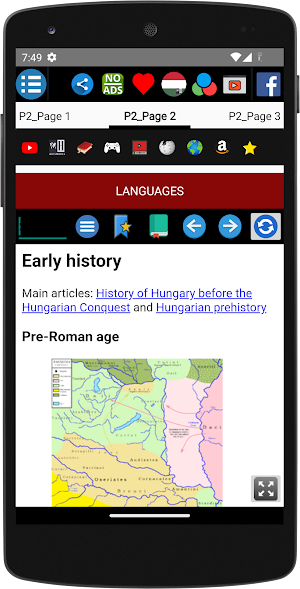







(Magyar)
Magyar történelem alatt a magyar nép és Magyarország történetét értjük. A Magyar Királyság létrejötte a magyar törzsek Kárpát-medencei honfoglalásához köthető. Ettől kezdve több mint 1000 éven át Magyarország története a Kárpát-medence történetével volt azonos. A magyar államalapítástól egészen 1918-ig a magyar történelem egyben a Magyar Királyság történetét is jelentette, annak valamennyi lakójával együtt. A Magyar Királyság több mint 900 éves történetének legnagyobb részében az egész Kárpát-medencét magában foglalta, ez alól csak a 150 éves török hódoltság kora kivétel.
1918-tól, illetve hivatalosan 1920-tól, a trianoni békeszerződés megkötésétől Magyarország állami területe a Kárpát-medence középső részére korlátozódik. Ettől az időtől kezdve magyar történelem alatt tehát elsősorban a mai Magyarország területének történetét értjük. Emellett a magyar történelem keretébe tartozik az 1920 óta a magyar államhatárokon kívül élő magyar kisebbségek, valamint a más országokban élő magyar emigráció története is.
(English)
Hungary in its modern (post-1946) borders roughly corresponds to the Great Hungarian Plain (the Pannonian Basin) in Central Europe.
During the Iron Age, it was located at the crossroads between the cultural spheres of the Celtic tribes (such as the Scordisci, Boii and Veneti), Dalmatian tribes (such as the Dalmatae, Histri and Liburni) and the Germanic tribes (such as the Lugii, Gepids and Marcomanni). The western part of the territory (the so-called Transdanubia) of modern Hungary formed part of Pannonia, a province of the Roman Empire. Roman control collapsed with the Hunnic invasions of 370–410, and Pannonia was part of the Ostrogothic Kingdom during the late 5th to mid 6th century, succeeded by the Avar Khaganate (6th to 9th centuries). The Hungarians took possession of the Carpathian Basin between 862 and 895. The Christian Kingdom of Hungary was established in 1000 under King Saint Stephen, ruled by the Árpád dynasty for the following three centuries. In the high medieval period, the kingdom expanded to the Adriatic coast and entered a personal union with Croatia in 1102. In 1241 Hungary was invaded by the Mongols under Batu Khan and decisively defeated at the Battle of Mohi. Hungary bore the brunt of the Ottoman wars in Europe during the 15th century. The Ottoman–Hungarian wars concluded in significant loss of territory and the partition of the kingdom after the Battle of Mohács of 1526. Defense against Ottoman expansion shifted to Habsburg Austria, and the remainder of the Hungarian kingdom came under the rule of the Habsburg emperors. The lost territory was recovered with the conclusion of the Great Turkish War. Following the nationalist uprisings of 1848, the Austro-Hungarian Compromise of 1867 elevated Hungary's status by the creation of a joint monarchy. The territory grouped under the Habsburg Archiregnum Hungaricum was much larger than modern Hungary, following the Croatian–Hungarian Settlement of 1868 which settled the political status of the Kingdom of Croatia-Slavonia within the Lands of the Crown of Saint Stephen.
Adolf Hitler (20 April 1889 – 30 April 1945) was an Austrian-born...
Liberia is a country in West Africa founded by free people of...
(English )Jewish history is the history of the Jews, and their nation,...
(Oromoo)Ka'umsi Oromoo eessaa akka ta'e sirriitti hubachuuf qorannoon dabalataa barbaachisuyyuu, Oromoon jalqabarratti...
(English)Ethiopia is one of the oldest countries in Africa; the emergence of...
Until roughly 2,000 years ago, what would become Zimbabwe was populated by...
Created with AppPage.net
Similar Apps - visible in preview.